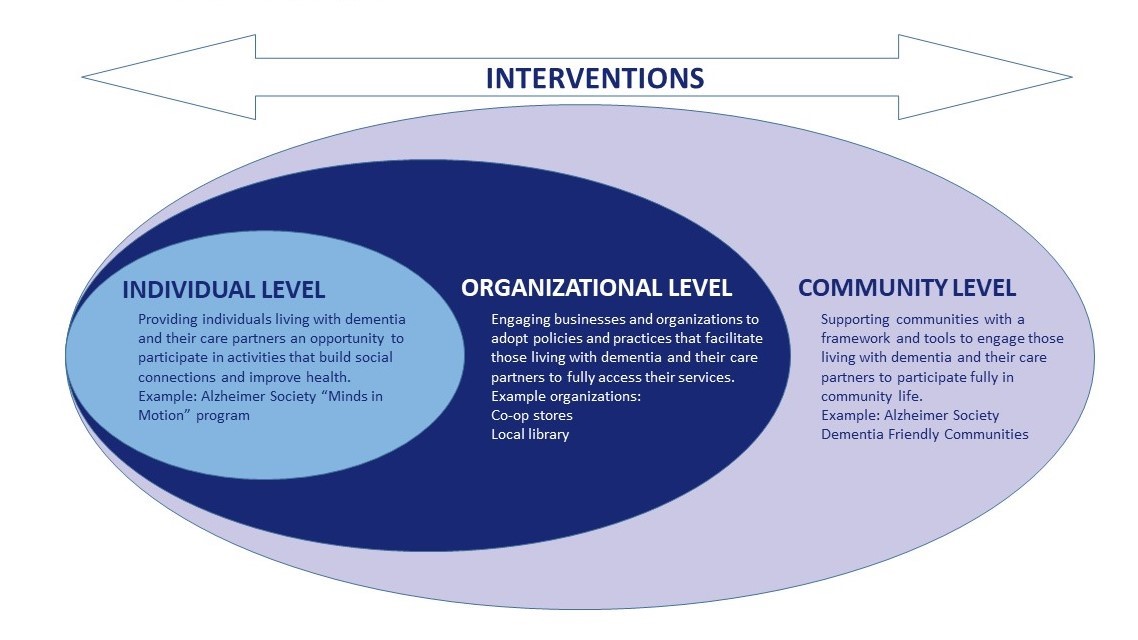
Enhancing Social Inclusion for Older Adults Living with Dementia: A Community-Based Collective Impact Approach in Rural Saskatchewan
The social isolation of older adults, especially those living with dementia, is a global challenge and Canada is no exception. Most factors that contribute to social isolation among older adults are systemic, such as the stigma of dementia, ageism, poverty, and inadequate access to resources and supports.
By Tom McIntosh, Akram Mahani, Bonnie Jeffery and Nuelle Novik, Saskatchewan Population Health and Evaluation Research Unit, University of ReginaThe social isolation of older adults, especially those living with dementia, is a global challenge and Canada is no exception. Most factors that contribute to social isolation among older adults are systemic, such as the stigma of dementia, ageism, poverty, and inadequate access to resources and supports. A new initiative from the Saskatchewan Population Health and Evaluation Research Unit (SPHERU) is working to reduce the stigma and enhance the social inclusion of older adults living with dementia and their care partners in rural Saskatchewan.
|
Box 1: The Saskatchewan Population Health and Evaluation Research Unit SPHERU is a bi-university research unit that exists at both the University of Regina and the University of Saskatchewan and which has a presence in Prince Albert, SK as well. It consists of an interdisciplinary group of scholars engaged in population health intervention research in with a focus on rural health, northern and Indigenous health, children’s health and the history of health inequities. Since 1999, SPHERU has established itself as a leader in cutting edge population health research that not only looks at the ‘what’ and ‘why of health inequities, but also how to address those inequities through action on the determinants of health. For further information on SPHERU’s approach to its research see its special 20th anniversary website: www.spheru20.ca |
With funding from Employment and Social Development Canada (ESDC), SPHERU is assisting community-based and civic organizations to develop, implement and evaluate interventions that will take place at individual, community and organizational levels.
Figure 1: Individual, Organizational and Community-level Interventions

This five-year initiative (2019-24) will implement and assess multiple interventions across these three levels in small cities and rural communities of Saskatchewan. Funds flow from SPHERU to Collaborating Organizations (community-based organizations, municipalities, businesses, service delivery agencies, etc.), to deliver the interventions. Collaborating Organizations agree to work within a collective impact approach for both delivery and assessment of the intervention.
Given the limited policy literature on collective impact, this Policy Brief outlines the design and implementation of a collective impact initiative and draws out potential policy implications. There is a wealth of literature on multi-sectoral (or inter-agency) collaboration and coalition-building that centres, for the most part, on breaking down silos in government. Collective impact, however, mostly targets the non-profit and community sector and is not well-documented in the policy literature.
What is Collective Impact?
The term collective impact was first introduced in an article published by John Kania and Mark Kramer in 2011 in the Stanford Social Innovation. Collective impact refers to social reforms that involve the commitment of a group of actors from different sectors to a common agenda for solving a specific complex social problem, using a structured form of collaboration. These multi-sectoral collaborations provide a framework to achieve systems-level changes in communities. It is premised on the presence of influential champions willing to commit to action on a specific issue, a shared perception of the urgency of the issue across sectors and organizations, and the availability of adequate resources to fund and implement the interventions and to support the work of the collective. Collective impact is a structured approach to problem solving that includes five core elements (see Box 1).
|
Box 2: Five Elements of Collective Impact
|
Why Dementia and Why Rural Saskatchewan?
Saskatchewan’s 1.1 million residents live in a geographic area the size of France (Hall & Offert, 2015). One-third of that population live in rural towns and communities, making it the second most rural province in the country. Age is the greatest risk factor for developing dementia, and the number of Saskatchewan residents aged 55+ is rising (Moazzami, 2015). Further, a recent study found that dementia and cognitive impairment are more prevalent among rural seniors than urban older adults (Weden et al., 2018). In Saskatchewan, older adults are more likely than younger persons to live in rural areas (Kosteniuk et al., 2015) as 15.5% of the rural population in Saskatchewan is aged 65+ (Moazzami, 2015).
More than 19,000 Saskatchewan residents live with dementia, and an estimated 60 per cent of those individuals reside in their own homes (Kosteniuk et al., 2015). By 2038, an estimated 25,800 Saskatchewan residents will have dementia, which is expected to cost more than $35.9 billion in health and caregiver costs. Community care is projected to become the dominant mode of dementia care in the province by 2028 (Smetanin et al., 2009). Services and programs targeting persons with dementia and their care partners are mainly concentrated in larger urban communities.
For the one-third of Saskatchewan’s population that live in smaller cities and rural communities, people living with dementia and their care partners face systemic barriers to accessing dementia care, including limited finances, education, transportation, and geographic distance (Jeffery et al., 2013). This points to both the importance of understanding the impact of dementia in rural communities and why Saskatchewan provides an important case study from which broader lessons can be learned.
Why Yorkton & Surrounding Area?
Our collective impact initiative is targeting adults living with dementia over the age of 55, and their care partners, who reside in Yorkton and the surrounding area, roughly the area of the former Sunrise Regional Health Authority. Sixteen thousand people live in Yorkton, but an additional 39,000 people reside in the many small towns, hamlets and rural municipalities in the catchment area. Beyond being in close proximity to SPHERU’s University of Regina base, the region has one of the oldest population distributions in the province. In addition, a key partner in the initiative, the Alzheimer’s Society of Saskatchewan, has recently opened a Yorkton office.
Figure 2: Communities in the former Sunrise Health Region

Launching the Initiative: Creating a Collective
In the first year of the project, we reached out to more than 100 community stakeholders (individuals and organizations) in Yorkton and the surrounding area to develop collaborations and partnerships. Because of the restrictions imposed by the COVID-19 pandemic we had to move our initial and ongoing contact with organizations on-line rather than using a more traditional face-to-face approach of community engagement.
Through a series on-line meetings and webinars we outlined both the goals of the initiative and sought to gauge interest from participants in developing and implementing interventions that SPHERU would fund and assist in evaluating. The goal is to have interventions at all three levels outlined in Figure 1 (broad public information campaigns, organizationally specific programs and direct services to individuals). SPHERU, as the backbone organization, is supported by an external Advisory Committee while a Community Impact Table made up of local community, public sector and civic organizations will support the Collaborating Organizations that agree to deliver interventions.
Through these conversations we have articulated a shared understanding of the problem(s) associated with living with dementia in rural areas, framed appropriate responses, and identified priority areas for interventions. These understandings create a framework for a shared agenda around mutually reinforcing activities that are at the heart of a collective impact approach. As the interventions themselves are launched, a common evaluation framework will be developed to track and assess progress. A number of factors have facilitated our efforts in forming our common agenda. These include:
- Strong history of community collaboration: SPHERU has a 20-year history of community-based research in the province as well as recent collaborations with some of the partner organizations involved here. The organizations from in and around Yorkton share a similar history of inter-agency, cross-sectoral collaboration which aligned easily with this project’s approach.
- Support from community leaders: Community leaders have been supportive of our project including local and provincial elected officials. In addition, the Advisory Committee includes members with lived experience with dementia who have proven to be strong advocates for the initiative.
- Social inclusion of older adults with dementia is a priority for the community: Community stakeholders are aware of the alarming situation of older adults experiencing social isolation and have demonstrated their understanding and willingness to address the issue.
- Enabling a continuous dialogue and learning: Our integrated community engagement strategy has fostered strong relationships and trust, raised awareness among various community members, and facilitated an exchange of ideas and proposals.
In late 2020 two foundational projects were completed. Prior to putting forward ideas for interventions there was a consensus amongst participating stakeholder groups that we needed a needs assessment that would investigate what services and programs were available to area residents with dementia or for their care partners. The assessment, conducted by Parkland Valley Sport, Culture and Recreation, found a reasonable availability of “services and/or programs that were broadly inclusive of people with a variety of special needs or were age-friendly for seniors” that might meet “some needs of people living with dementia.” (Parkland Valley, 2021, p.10). But there were few programs or services identified that were dementia-specific.
The assessment also revealed that many of the existing services had been curtailed, moved online or cancelled due to the COVID-19 pandemic. Further, access to those services that moved on-line was hampered by limited connectivity in the catchment area and discomfort with accessing services on-line (Parkland Valley, 2021). The assessment also confirmed the need for further public awareness about dementia.
The second project, completed by the SPHERU team was a population survey of 404 residents 18 years and older in the project area to assess level of knowledge of, and stigma related to dementia (Jeffery et al., 2021). One of the key findings from the survey is the low level of the public’s actual knowledge of dementia compared to their perceived (self-rated) knowledge. It also found that stigma is the main reason identified for reluctance to share a diagnosis of dementia with others; Both of these factors could result in delayed help-seeking and further increase feelings of social isolation. The findings from the survey also confirm the need for greater public awareness and knowledge of dementia. A second survey will be commissioned in year four of the initiative to assess population-level changes in knowledge over time given the presence of the local interventions being developed and implemented.
We expect all funded interventions to roll out by the end of 2021 when the evaluation of those interventions will start simultaneously using a shared measurement protocol co-designed with the Collaborating Organizations.
|
Box 3: Collective Impact Interventions, Funded and Proposed Interventions Funded to Date (March 2021)
Interventions Under Development (March 2021)
|
Potential Policy Implications
Collective Impact has created a significant reform in the approach of governments and foundations to community coalition building and multi-sector collaboration in communities. It is a variant of the older concept of multi-sector collaboration that was mostly applied to government agencies, with specific application to the non-profit community sector. The policy implications we draw from current and past collective impact and other multi-sectoral collaboration projects are categorised into four key themes including: bottom-up community-driven approach, continuous communication and integrated engagement, building trust, and continuous learning.
Bottom-up community-driven approach: One important lesson is that communities and people most affected by the issue need to be meaningfully engaged in driving the collective impact initiative. This approach supports community ownership which can lead to more effective implementation of co-designed interventions/solutions. In a collective impact initiative with a truly bottom-up approach, the Backbone Organization’s role is to support community stakeholders’ leadership instead of leading the initiative.
Continuous communication and integrated engagement: An effective collective impact initiative encourages diverse and inclusive engagement. To this end, we have focused on bringing together a wide range of community stakeholders and actors to the table, from CEO level cross-sector leaders to persons directly affected by the issue (persons living with dementia and their care partners). By adopting an integrated engagement and communication strategy, diverse groups work together to address the issue and tackle the barriers to change.
Building trust: Our experience in designing, implementing, and evaluating collective impact projects suggests that the sustainability and effectiveness of a collective impact initiative depends strongly on trust, especially when collaboration is voluntary. That trust is built through continuous communication to foster a sense of commonality and reciprocity in win–win partnerships.
Continuous learning: Collective impact is not viewed as a solution, but as a problem-solving process, which requires continuous learning and adaptation in order to be successful. This includes organizational or process learning as well as the collective learning of community members. Performance measurement and evaluation, that should be embedded into the entire collective impact stages, are designed to support organizational or process learning through regular feedback resulting in improvement and adaptation.
Challenges
Collective impact initiatives are not without challenges. The key challenges include: the scale up and spread of interventions, evaluation of collective impact, time for relationship-building, and power dynamics.
Scale and spread: One of the major challenges we envision is the ability to scale-up and spread multi-level interventions and transfer them to different community contexts. To mitigate this challenge, we have adopted a realist evaluation that addresses questions of what mechanisms work, for whom, and under what conditions and contexts. Realist evaluation is concerned not just with the outcomes of interventions but also with the process, context, and mechanisms by (-in) which these interventions are planned, developed, and implemented. This should inform how some of these interventions could be scaled up and spread to other rural communities in Saskatchewan and beyond.
Evaluation of collective impact: Evaluation of collective impact as a whole, not merely evaluation of single interventions, remains a challenge. While the literature on evaluation of single interventions is abundant, evaluation of multiple interventions run by diverse organizations and stakeholders within a collective remains scarce. We know little about how shared measurement differs from measuring outcomes of specific interventions within a collective impact project. We are conducting a scoping review to explore global literature on diverse evaluation methods, frameworks and techniques to examine the evidence on their success.
Time for trust and relationship building: System change is about change in the relationships of people who shape those systems. This highlights the importance of relationships that become both the means and the ends. Building relationships and trust takes a significant amount of time and resources.
Power dynamic: A common challenge to collective impact is unequal power relationships and vested interests among community partners. According to collective action theory in multi-sectoral collaboration (Olson, 1968) each stakeholder does not voluntarily act to advance group interests unless they see benefits and are offered an incentive. In our project, to mitigate power dynamics and prevent domination by a particular community partner, each meeting is facilitated to give all community partners equal voice. In co-designing our common agenda, we have ensured that all community members can clearly see areas of co-benefits and how each partner can benefit from the collaboration.
Conclusion
References
Hall, H., & Olfert, R. (2015). State of rural Canada. http://sorc.crrf.ca/saskatchewan/
Jeffery, B., Novik, N., McIntosh, T. & Mahani, A. (2021). Dementia knowledge survey, Regina/Saskatoon: Saskatchewan Population Health and Evaluation Research Unit.
Jeffery, B., Bacsu, J., & Abonyi, S. (2013). Healthy aging in place: Rural healthy aging interventions: Findings from a longitudinal study in rural Saskatchewan. Regina/Saskatoon: Saskatchewan Population Health and Evaluation Research Unit.
Kosteniuk, J.Gs, Morgan, D.G., Quail, J.M., Teare, G.T., Kulyk, K., O’Connell, M.E., Kirk, A., Crossley, M., Stewart, N.J., Dal Bello-Haas, V., McBain, L., Mou, H., Forbes, D., Innes, A., Bracken, J., & Parrott, E. (2015). A multi-ethod investigation of dementia and related services in Saskatchewan: Final report and recommendations. Saskatoon, Saskatchewan: University of Saskatchewan.
Moazzami, B. (2015) Strengthening rural Canada: Fewer and lder: Population and demographic challenges across rural Canada, A Pan-Canadian report. Ottawa: Government of Canada.
Olson, M. (1968). The oogic of collective action: Public goods and the theory of groups. Cambridge, Mass: Harvard University Press.
Parkland Valley Community, Sport and Recreation District. (2021). Dementia project: Final report. https://www2.uregina.ca/SPHERU-dementiasupports/wp-content/uploads/2021/02/PVSCRD-Dementia-Final-Report-02012021.pdf
Smetanin, P., Kobak, P., Briante, C., Stiff, D., Sherman, G., & Ahmad, S. (2009). Rising tide: The impact of dementia in Manitoba, 2008 to 2038. RiskAnalytica, 2009.
Weden, MM, Shih, RA, Kabeto MU, & Langa, KM. (2018). Secular trends in dementia and cognitive impairment of US rural and urban older adults. American Journal of Preventative Medicine, 54(2), 164-172.
Tom McIntosh

Dr. Tom McIntosh (PhD) is a professor of Politics and International Studies and Co-Director of SPHERU at the University of Regina. His research is focuses on the governance of health policy and the reduction of health inequities across different populations.
Akram Mahani

Dr. Akram Mahani (PhD) is a researcher with a background in multiple public health, health promotion, health policy, and health services research areas. She is currently the Evaluation Coordinator for SPHERU’s Dementia Supports in Rural Saskatchewan project.
Bonnie Jeffery

Dr. Bonnie Jeffery (PhD) is a professor of Social Work at the University of Regina and a Researcher with SPHERU. For the last decade she has been leading a research program that addresses individual, community and policy responses that can support successful aging in place for older adults.
Nuelle Novik

Dr. Nuelle Novik (PhD) is an Associate Professor of Social Work at the University of Regina, a researcher with SPHERU and a community social work therapist. Her research is focused on aging and older adults, rural and remote practice, mental health, and grief and loss support.

